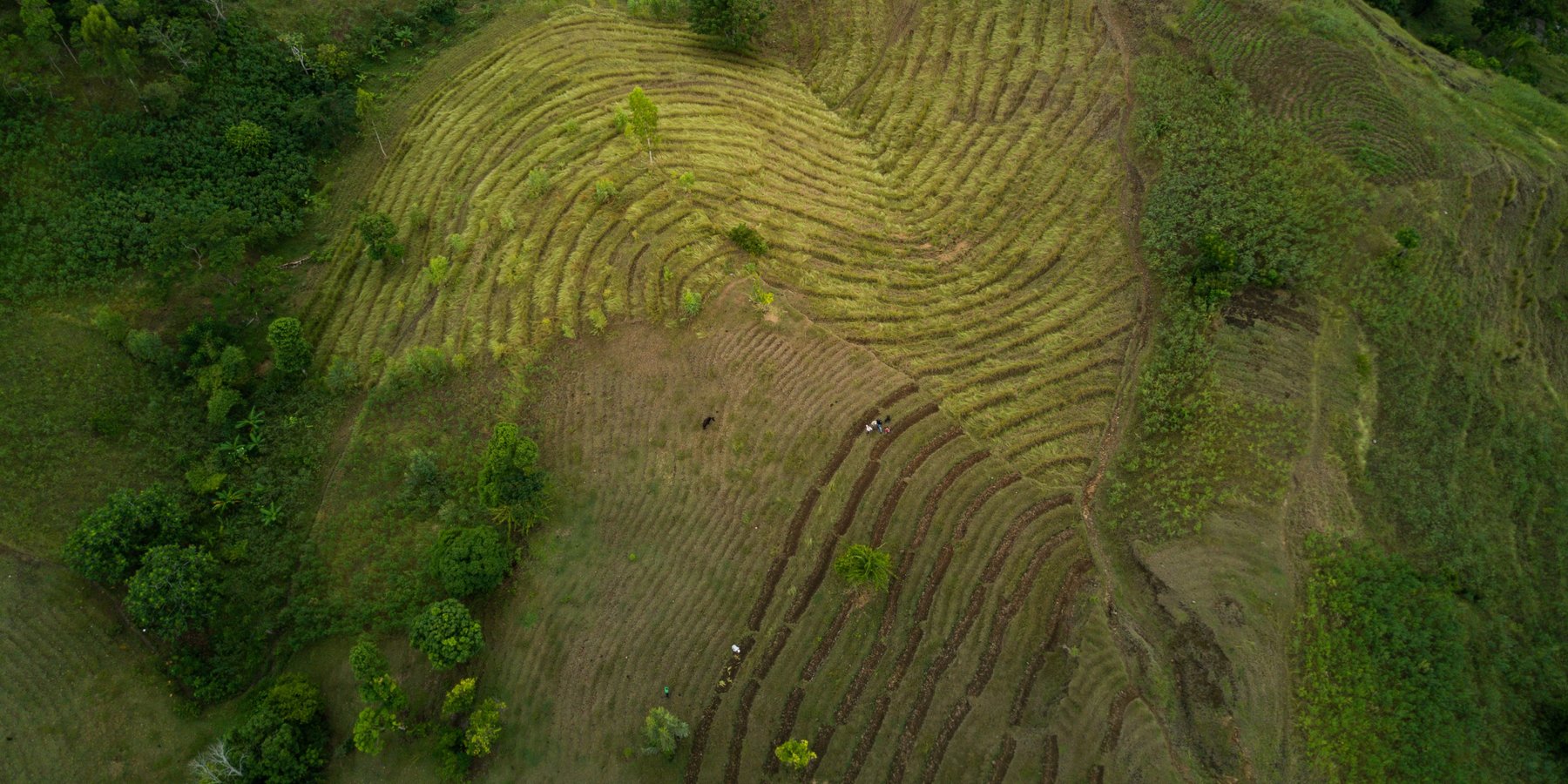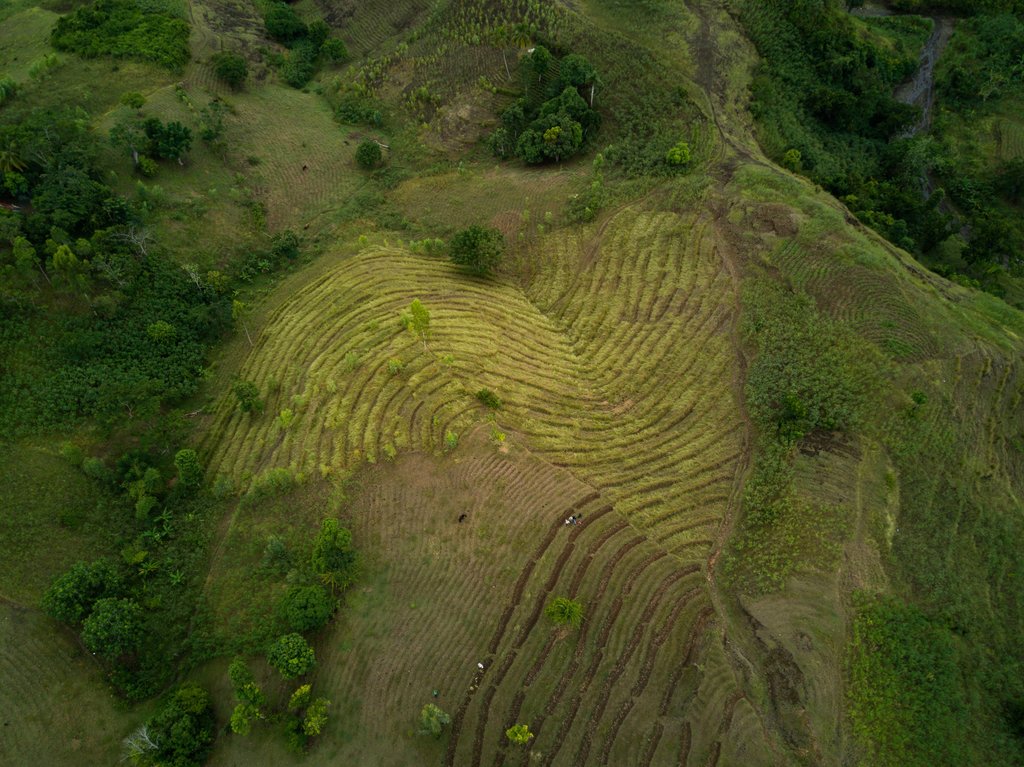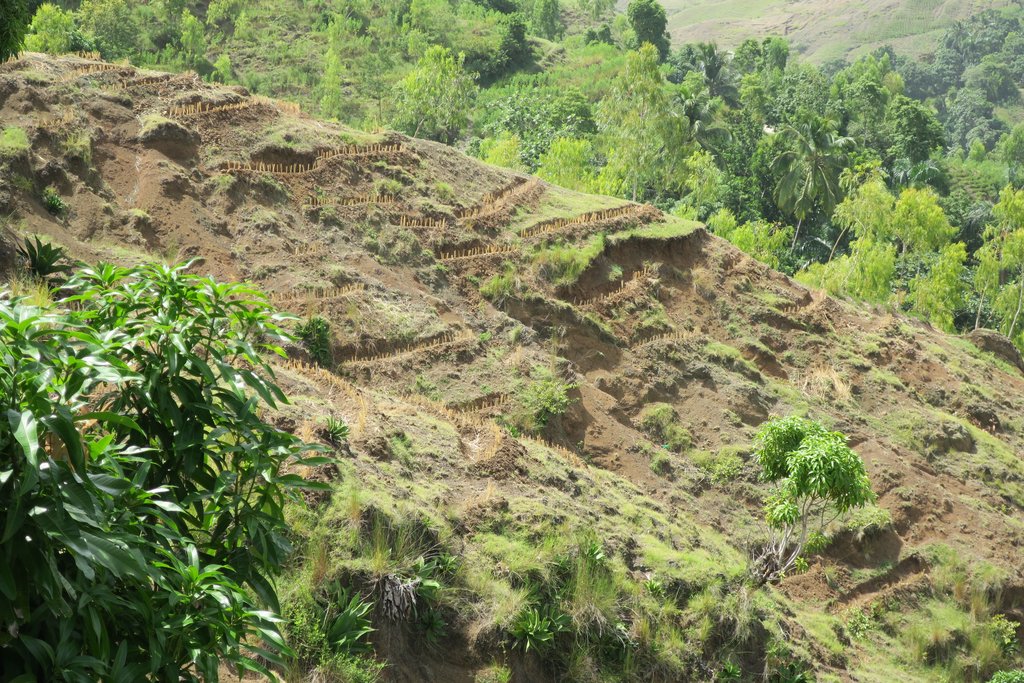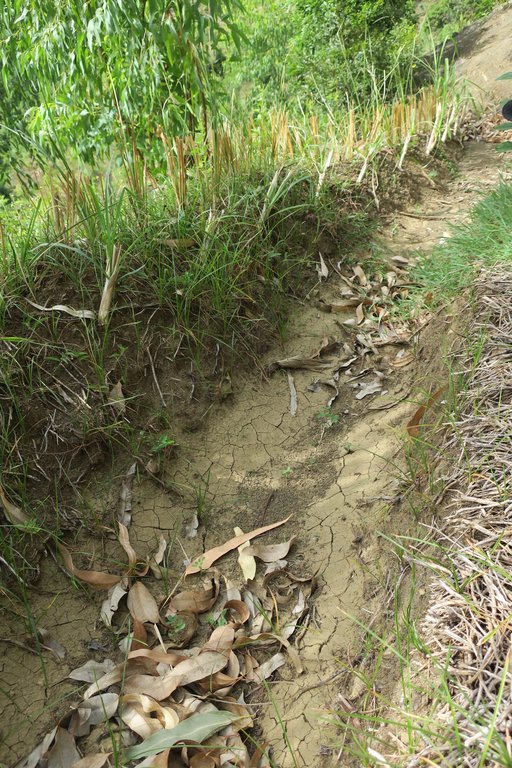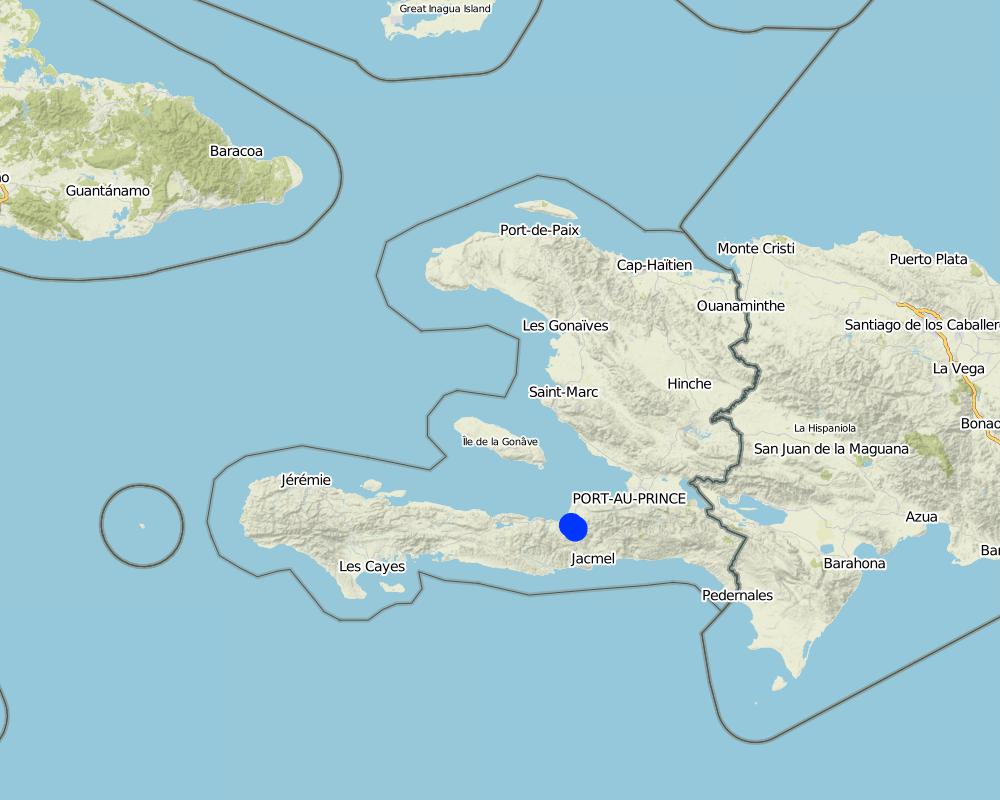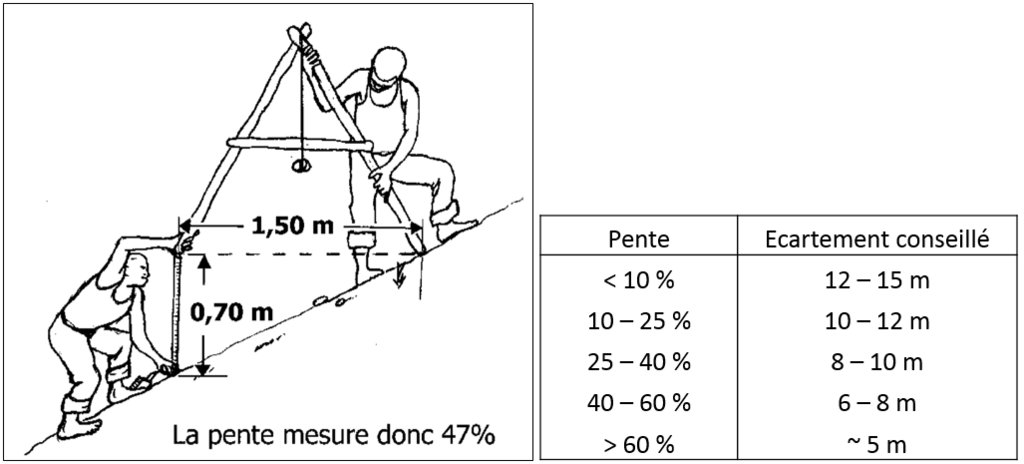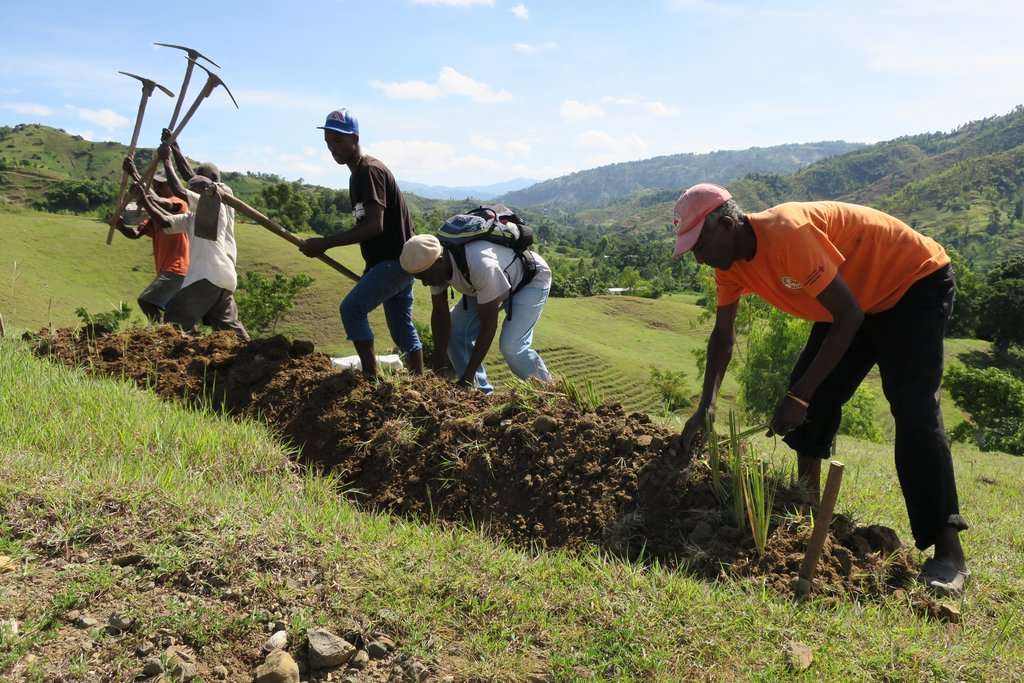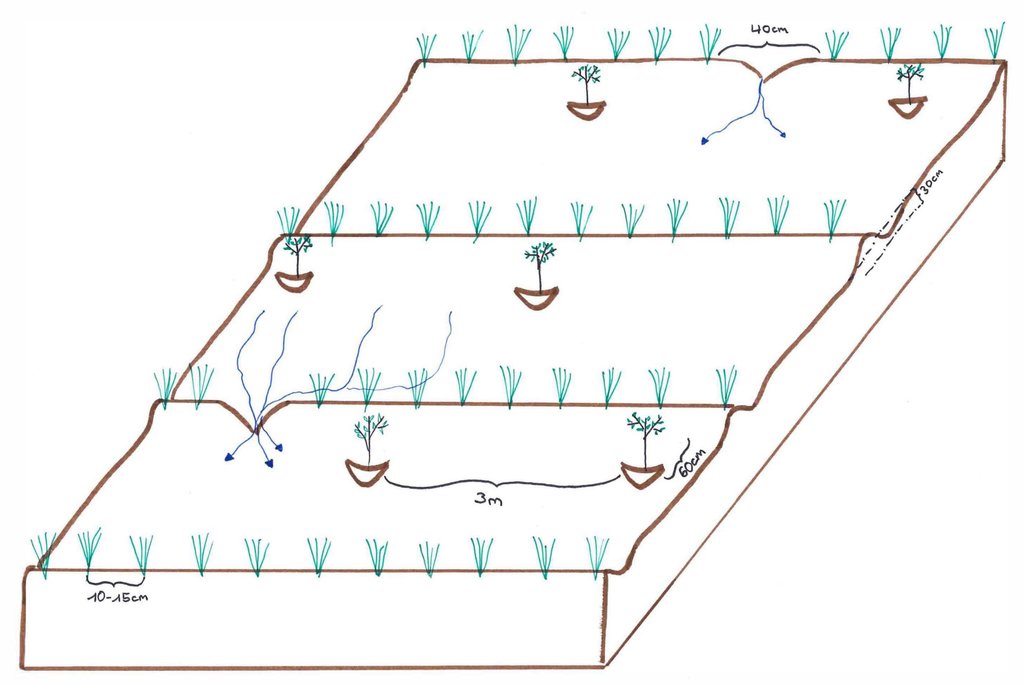Progressive bench terraces formed by a vetiver hedge system and trees [海地]
- 创建:
- 更新:
- 编制者: Joana Eichenberger
- 编辑者: Jean Carls Dessin, Hanspeter Liniger
- 审查者: Hanspeter Liniger
Ranp vivan (fran. rampes vivantes)
technologies_3223 - 海地
- Progressive bench terraces formed by a vetiver hedge system and trees: Feb. 23, 2019 (inactive)
- Progressive bench terraces formed by a vetiver hedge system and trees: June 16, 2020 (inactive)
- Progressive bench terraces formed by a vetiver hedge system and trees: April 16, 2020 (inactive)
- Terrassement progressif à vétiver: Feb. 16, 2019 (inactive)
- Progressive bench terraces formed by a vetiver hedge system and trees: June 27, 2021 (public)
查看章节
全部展开 全部收起1. 一般信息
1.2 参与该技术评估和文件编制的资源人员和机构的联系方式
Technician:
海地
有助于对技术进行记录/评估的机构名称(如相关)
Swiss Red Cross (Swiss Red Cross) - 瑞士1.3 关于使用通过WOCAT记录的数据的条件
编制者和关键资源人员接受有关使用通过WOCAT记录数据的条件。:
是
1.4 所述技术的可持续性声明
这里所描述的技术在土地退化方面是否存在问题,导致无法被认为是一种可持续的土地管理技术?:
否
2. SLM技术的说明
2.1 技术简介
技术定义:
The progressive terracing technology results from successive deposits of sediments upstream of any other anti-erosional structure, in this case vetiver grass hedges (vetiveria zizanioides). To better stabilize the slopes in the long-term, new trees are planted downstream of the vetiver hedges.
2.2 技术的详细说明
说明:
The technology can be implemented wherever slopes are being cultivated. Ideally, it would be applied as a preventive measure in lands where the land is still in good condition. In Haiti, however, the Swiss Red Cross (CRS) uses it instead as a restoration measure where soil has already been degraded by surface erosion. The principle of terracing consists of reshaping the terrain of a given slope into a succession of steep slopes and platforms with little or no gradient. Progressive terraces result from successive deposits of sediments upstream of any other anti-erosion structure. To make the anti-erosive structure, the CRS in Haiti uses mostly vetiver grass because vetiver 1) has deep roots, 2) can be cut and used as mulch and 3) is easily accessible and well known in Haiti thanks to the fragrance industry. Below (downstream) the vetiver hedges, tree seedlings are planted to better stabilize the soil in the long-term. Ideally, fruit trees would be planted so that land users could benefit more. However, if the soil is to degraded, forest trees are better suited since they are less demanding. Between the vetiver hedges, the landholders can cultivate crops. It is recommended not to use crops whose roots are consumed (potatoes, peanuts, cassava, etc.), but to plant legumes that fix nitrogen and / or perennial crops. From time to time vetiver can be cut and used as mulching.
The progressive terracing with vetiver has two objectives: On the one hand, by stabilizing the slopes with its deep roots and by retaining the rainwater runoff and the eroded sediments in the canals upstream the hedges, this technology protects communities and crops downstream against landslides, floods and siltation. On the other hand, the terraces are supposed to have a favorable effect on the water sources: by retaining it in the channels, the water can infiltrate more easily into the ground and recharge the aquifers. Like that, in times of drought, the water table has more reserve of water. In addition, this technique has the advantage of restoring degraded slopes since the sediments accumulated in the canals are fertile and allow agriculture between the terraces.
Unlike mechanical terraces, progressive terraces need less work for setting up. They are also less expensive than dry stone terraces and it is easier to transport vetiver plants than stones.
The disadvantage is that land users are afraid of losing arable land with this technology. They exploit their plots as much as possible and apply it only when the soil is completely degraded. Another disadvantage is that the oil extracted from the roots of vetiver is very sought-after in the fragrance industry. Therefore, from time to time there are people who dig up the vetivers in order to sell its roots.
2.3 技术照片
2.5 已应用该技术的、本评估所涵盖的国家/地区/地点
国家:
海地
区域/州/省:
Département de l'Ouest
有关地点的进一步说明:
Léogâne
具体说明该技术的分布:
- 均匀地分布在一个区域
如果不知道精确的区域,请注明大致覆盖的区域:
- 0.1-1 平方千米
技术现场是否位于永久保护区?:
否
Map
×2.6 实施日期
注明实施年份:
2014
2.7 技术介绍
详细说明该技术是如何引入的:
- 通过项目/外部干预
3. SLM技术的分类
3.1 该技术的主要目的
- 改良生产
- 减少、预防、恢复土地退化
- 结合其他技术保护流域/下游区域
- 降低灾害风险
- 适应气候变化/极端天气及其影响
- adapt to steep slopes
3.2 应用该技术的当前土地利用类型

农田
- 一年一作
- 多年一作(非木材)
年作 - 具体指明作物:
- 油料作物 - 花生
- 谷物类 - 玉米
- 根/块茎作物 - 红薯、山药、芋头/椰子,其他
多年生(非木质)作物 - 指定作物:
- 香蕉/芭蕉/蕉麻
- 甘蔗
- pigeon peas
每年的生长季节数:
- 2
具体说明:
Mar-May and Sep-Oct
采用间作制度了吗?:
是
如果是,说明哪些作物是间作的:
pigeon peas and sweet potatoes

森林/林地
- 植树造林
植树造林:说明树种的起源和组成:
- 混交品种
以上的树木是落叶树还是常绿树?:
- 落叶植物
产品和服务:
- 水果和坚果
- 自然保持/保护
注释:
This technology can be implemented wherever slopes are being cultivated. Normally the technology is used as a restoration measure when the soil has already been degraded by weeded/ ploughed crops.
3.3 由于技术的实施,土地使用是否发生了变化?
由于技术的实施,土地使用是否发生了变化?:
- 是(请在技术实施前填写以下有关土地利用的问题)
同一土地单元内混合使用的土地::
否

农田
- 一年一作
- 多年一作(非木材)
年作 - 具体指明作物:
- 油料作物 - 花生
- 谷物类 - 玉米
- 根/块茎作物 - 红薯、山药、芋头/椰子,其他
多年生(非木质)作物 - 指定作物:
- 香蕉/芭蕉/蕉麻
- 甘蔗
- pigeon peas
采用间作制度了吗?:
是
如果是,说明哪些作物是间作的:
pigeon peas and sweet potatoes

不毛之地
具体说明:
The soil has been too degraded by the weeded/ploughed crop practice and has become unproductive.
3.4 供水
该技术所应用土地的供水:
- 雨养
3.5 该技术所属的SLM组
- 横坡措施
- 减少基于生态系统的灾害风险
- In the long term: agroforestry
3.6 包含该技术的可持续土地管理措施

农艺措施
- A2:有机质/土壤肥力

植物措施
- V1:乔木和灌木覆盖层
- V2:草和多年生草本植物

结构措施
- S1:阶地
注释:
A2: Vetiver grass can be cut and used for mulching.
V1: The SRC combines the technology of progressive terracing with vetiver hedges with reforestation.
3.7 该技术强调的主要土地退化类型

土壤水蚀
- Wt:表土流失/地表侵蚀
- Wg:冲沟侵蚀/沟蚀
- Wm:块体运动/滑坡
- Wo:场外劣化效应

水质恶化
- Ha:干旱化
- Hs:地表水良变化
- Hg:地下水/含水层水位的变化
- Hp:地表水水质下降
注释:
Hg: assumption
3.8 防止、减少或恢复土地退化
具体数量名该技术与土地退化有关的目标:
- 减少土地退化
- 修复/恢复严重退化的土地
注释:
Ideally, the technique would be applied to prevent degradation, but in Haiti, it is used as a measure to reduce land degradation and to restore severely degraded land.
4. 技术规范、实施活动、投入和成本
4.1 该技术的技术图纸
技术规范(与技术图纸相关):
In order to implement this technology, the average slope has to be measured first. This is done with a "A-level"-called instrument. By placing one foot to the A-level and raising the lower foot (downstream in the direction of the slope), the A-level should be placed in a horizontal position. The slope corresponds to p=h/l*100, for p = slope, h = distance from the downstream foot of A-level to the ground, and l = distance between the two feet of level A. The average slope defines the distance between the vetiver lines. The steeper the slope, the smaller the distance.
作者:
Régis and Roy
日期:
1999
技术规范(与技术图纸相关):
After having calculated the average slope of the terrain, one can start picketing the contour lines where the vetivers will be planted. First, an alignment in the direction of the slope from upstream to downstream is done by planting stakes. The first stake is placed at the upper limit of the plot, the distance the other stakes is a function of the average slope of the terrain (here: 50% --> 7m). This alignment forms the baseline. Once the baseline is set, the contour lines can be picketed. This is done again with the A-level instrument.
作者:
Régis and Roy
日期:
1999
技术规范(与技术图纸相关):
In a third step, channels (about 30cm deep) are dug following the picketed contour lines. The material removed is used to form ridges downstream of the channels. On the ridges, vetiver cuttings are planted every 10-15cm.
作者:
Joana Eichenberger
日期:
03/10/2017
技术规范(与技术图纸相关):
It is recommended to leave a space of approx. 40cm in each line (see drawing). These spaces a) facilitate the passage for the land users once the vetiver grass is high and b) make it possible for extra water to escape (if there is too much water accumulated in the channels, the ridgesmay break). 60cm downstream of the vetiver hedges, fruit or forest tree seedlings are planted every 3m. After about three months, the roots of the vetivers are deep enough. Depending on the soil degradation’s degree, land users may begin to cultivate the spaces between the lines.
作者:
Joana Eichenberger
日期:
29/06/2018
4.2 有关投入和成本计算的一般信息
具体说明成本和投入是如何计算的:
- 每个技术单元
指定单位:
Vetiver line
指定单位面积(如相关):
200m
其它/国家货币(具体说明):
HTG
如相关,注明美元与当地货币的汇率(例如1美元=79.9巴西雷亚尔):1美元=:
62.0
注明雇用劳工的每日平均工资成本:
200 HTG per person and day
4.3 技术建立活动
| 活动 | 时间(季度) | |
|---|---|---|
| 1. | If necessary: deforest the plot | |
| 2. | Measure the slope with A-level and calculate the necessary distance between the lines of vetiver | |
| 3. | Mark out the contour lines (put a stake every 3m) | Beginning of the rainy season so that the vetiver can grow well -> March / April |
| 4. | Dig a channel following marked contour lines | March / April |
| 5. | Plant the vetiver seedlings every 10-15cm on the ridges of soil below(downstream) the canal | March / April |
| 6. | Plant the tree seedlings every 3m below (downstream) the vetiver lines | March / April |
4.4 技术建立所需要的费用和投入
| 对投入进行具体说明 | 单位 | 数量 | 单位成本 | 每项投入的总成本 | 土地使用者承担的成本% | |
|---|---|---|---|---|---|---|
| 劳动力 | Unskilled labourer | person-days | 20.0 | 200.0 | 4000.0 | 100.0 |
| 劳动力 | Skilled labourer | person-days | 5.0 | 1000.0 | 5000.0 | |
| 设备 | Machete | pieces | 1.0 | 5.0 | 5.0 | 100.0 |
| 设备 | Pickaxe | pieces | 3.0 | 5.0 | 15.0 | 100.0 |
| 设备 | A-level | pieces | 1.0 | 5.0 | 5.0 | 100.0 |
| 设备 | Hoe | pieces | 5.0 | 5.0 | 25.0 | 100.0 |
| 植物材料 | Vetiver grass | cuttings | 2000.0 | 2.0 | 4000.0 | |
| 植物材料 | Trees | cuttings | 67.0 | 50.0 | 3350.0 | |
| 技术建立所需总成本 | 16400.0 | |||||
| 技术建立总成本,美元 | 264.52 | |||||
如果土地使用者负担的费用少于100%,请注明由谁负担其余费用:
Unskilled labour is provided by the community based organizations (OCB). The Swiss Red Cross offers a technician (skilled labor). The equipment (hoes, picks, ...) are provided by labouers themselves or the OCBs. Vetiver and tree cuttings are provided by the community.
4.5 维护/经常性活动
| 活动 | 时间/频率 | |
|---|---|---|
| 1. | Replant dead cuttings | 2 times a year |
| 2. | Reparing broken ridges | 2 times a year |
| 3. | Verify if ridges are ok | In the beginning once a month, after that only once every three months |
| 4. | Cultivate normally | From tree months after implementation |
4.6 维护/经常性活动所需要的费用和投入(每年)
| 对投入进行具体说明 | 单位 | 数量 | 单位成本 | 每项投入的总成本 | 土地使用者承担的成本% | |
|---|---|---|---|---|---|---|
| 劳动力 | Land user and his family (monthly check, 1/2 day of work for 200m) | person-days | 6.0 | 200.0 | 1200.0 | 100.0 |
| 劳动力 | Replanting dead cuttings and reparing ridges (2 times a year total 5 working days for 20 people) | person-days | 100.0 | 200.0 | 20000.0 | 100.0 |
| 设备 | Hoe | pieces | 1.0 | 5.0 | 5.0 | 100.0 |
| 植物材料 | Vetiver cuttings replaced after rainy season (5%) | cuttings | 65.0 | 2.0 | 130.0 | |
| 植物材料 | Vetiver cuttings replaced after dry period (40%) | cuttings | 533.0 | 2.0 | 1066.0 | |
| 技术维护所需总成本 | 22401.0 | |||||
| 技术维护总成本,美元 | 361.31 | |||||
如果土地使用者负担的费用少于100%,请注明由谁负担其余费用:
Labor is provided by the OCBs. The equipment (hoes, picks, ...) are provided by labourers themselves or OCBs. Vetiver and tree cuttings are provided by the community
注释:
The costs depend a lot on the proportion of the damage and the damage depends on the weather. It is recommended to implement the measurement at the begining of the rainy season.
Land users have the necessary tools (the 5 HTGs are budgeted as compensation cost for using their own tools).
4.7 影响成本的最重要因素
描述影响成本的最决定性因素:
1) Skilled labourers
2) Maintenance costs depends very much on the weather: if it rains too much, runoff destroys the ridges by forms gullies and remove the vetiver cuttings which were not sufficiently rooted. If it does not rain enough during the first weeks, the vetivers can not form roots, dry out and must be replaced.
5. 自然和人文环境
5.1 气候
年降雨量
- < 250毫米
- 251-500毫米
- 501-750毫米
- 751-1,000毫米
- 1,001-1,500毫米
- 1,501-2,000毫米
- 2,001-3,000毫米
- 3,001-4,000毫米
- > 4,000毫米
有关降雨的规范/注释:
The windward sides (north slopes) receive up to three times more rain than the lee sides.
Dry season1: Nov-Mar
Rainy season1: Apr-Mai
Dry season2: Jun-Jul
Rainy season2: Aug-Oct
(Due to climate change, the first rainy season tends to starts later than it used to)
农业气候带
- 半湿润
Mean annual temperature: 25-27°C
5.2 地形
平均坡度:
- 水平(0-2%)
- 缓降(3-5%)
- 平缓(6-10%)
- 滚坡(11-15%)
- 崎岖(16-30%)
- 陡峭(31-60%)
- 非常陡峭(>60%)
地形:
- 高原/平原
- 山脊
- 山坡
- 山地斜坡
- 麓坡
- 谷底
垂直分布带:
- 0-100 m a.s.l.
- 101-500 m a.s.l.
- 501-1,000 m a.s.l.
- 1,001-1,500 m a.s.l.
- 1,501-2,000 m a.s.l.
- 2,001-2,500 m a.s.l.
- 2,501-3,000 m a.s.l.
- 3,001-4,000 m a.s.l.
- > 4,000 m a.s.l.
说明该技术是否专门应用于:
- 不相关
5.3 土壤
平均土层深度:
- 非常浅(0-20厘米)
- 浅(21-50厘米)
- 中等深度(51-80厘米)
- 深(81-120厘米)
- 非常深(> 120厘米)
土壤质地(表土):
- 粗粒/轻(砂质)
- 中粒(壤土、粉土)
土壤质地(地表以下> 20厘米):
- 粗粒/轻(砂质)
- 中粒(壤土、粉土)
表土有机质:
- 低(<1%)
如有可能,附上完整的土壤描述或具体说明可用的信息,例如土壤类型、土壤酸碱度、阳离子交换能力、氮、盐度等。:
In Haiti this technology is applied on very degraded sites with very shallow soil. But normally it is advisable to have a ground of a minimum of 25cm of depth (Régis and Roy 1999).
The technology can be applied everywhere, therefore, the soil can be sandy, loamy/silty or clay
5.4 水资源可用性和质量
地下水位表:
5-50米
地表水的可用性:
中等
水质(未处理):
不良饮用水(需要处理)
水的盐度有问题吗?:
否
该区域正在发生洪水吗?:
否
5.5 生物多样性
物种多样性:
- 高
栖息地多样性:
- 高
5.6 应用该技术的土地使用者的特征
定栖或游牧:
- 定栖的
生产系统的市场定位:
- 混合(生计/商业)
非农收入:
- 低于全部收入的10%
相对财富水平:
- 贫瘠
个人或集体:
- 团体/社区
机械化水平:
- 手工作业
性别:
- 男人
土地使用者的年龄:
- 青年人
- 中年人
说明土地使用者的其他有关特征:
Land users age: young, middle-aged and elderly.
5.7 应用该技术的土地使用者使用的平均土地面积
- < 0.5 公顷
- 0.5-1 公顷
- 1-2 公顷
- 2-5公顷
- 5-15公顷
- 15-50公顷
- 50-100公顷
- 100-500公顷
- 500-1,000公顷
- 1,000-10,000公顷
- > 10,000公顷
这被认为是小规模、中规模还是大规模的(参照当地实际情况)?:
- 小规模的
- 中等规模的
5.8 土地所有权、土地使用权和水使用权
土地所有权:
- 个人,未命名
土地使用权:
- 自由进入(无组织)
用水权:
- 自由进入(无组织)
- 社区(有组织)
5.9 进入服务和基础设施的通道
健康:
- 贫瘠
- 适度的
- 好
教育:
- 贫瘠
- 适度的
- 好
技术援助:
- 贫瘠
- 适度的
- 好
就业(例如非农):
- 贫瘠
- 适度的
- 好
市场:
- 贫瘠
- 适度的
- 好
能源:
- 贫瘠
- 适度的
- 好
道路和交通:
- 贫瘠
- 适度的
- 好
饮用水和卫生设施:
- 贫瘠
- 适度的
- 好
金融服务:
- 贫瘠
- 适度的
- 好
6. 影响和结论性说明
6.1 该技术的现场影响
社会经济效应
生产
作物生产
注释/具体说明:
As the land was too degraded, one has to patient. But in the long run agricultural production will increase.
作物质量
注释/具体说明:
As the land was too degraded, one has to patient. But in the long run crop quality will increase.
生产故障风险
产品多样性
生产区域
水资源可用性和质量
饮用水的可用性
收入和成本
农业收入
注释/具体说明:
As the land was too degraded, one has to patient. But in the long run farm income will increase.
社会文化影响
食品安全/自给自足
注释/具体说明:
As the land was too degraded, one has to patient. But in the long run food security will increase.
SLM/土地退化知识
生态影响
水循环/径流
水量
地表径流
蒸发
土壤
土壤水分
土壤覆盖层
土壤流失
土壤堆积
土壤结壳/密封
生物多样性:植被、动物
植被覆盖
减少气候和灾害风险
洪水影响
滑坡/泥石流
干旱影响
飓风、暴雨的影响
碳和温室气体的排放
微气候
对现场影响的评估(测量)进行具体说明:
The impacts are just estimates, they have not been quantified yet.
6.2 该技术的场外影响已经显现
水资源可用性
旱季稳定可靠的水流
下游淤积
对邻近农田的破坏
对公共/私人基础设施的破坏
对场外影响(测量)的评估进行具体说明:
The impacts are just estimates, they have not been quantified yet.
6.3 技术对渐变气候以及与气候相关的极端情况/灾害的暴露和敏感性(土地使用者认为的极端情况/灾害)
气候有关的极端情况(灾害)
气象灾害
| 该技术是如何应对的? | |
|---|---|
| 热带风暴 | 好 |
| 局地暴雨 | 好 |
气候灾害
| 该技术是如何应对的? | |
|---|---|
| 干旱 | 好 |
水文灾害
| 该技术是如何应对的? | |
|---|---|
| 滑坡 | 非常好 |
注释:
The first period of rain is shifting (March-May -> April-June);
For vetiver grass, the first 3 months are decisive: there must be neither too much nor too little rain. After these three months, the drought has a negligible impact.
The SRC receives many positive feedbacks on this technology. The communities appreciate its benefits.
6.4 成本效益分析
技术收益与技术建立成本相比如何(从土地使用者的角度看)?
短期回报:
稍微积极
长期回报:
积极
技术收益与技术维护成本/经常性成本相比如何(从土地使用者的角度看)?
短期回报:
稍微积极
长期回报:
积极
注释:
If the slopes were too degraded, it is necessary to wait a few months / years until land users can enjoy the benefits of this technology.
6.5 技术采用
- 1-10%
在所有采用这项技术的人当中,有多少人是自发的,即未获得任何物质奖励/付款?:
- 0-10%
6.6 适应
最近是否对该技术进行了修改以适应不断变化的条件?:
是
其它(具体说明):
Terrain conditions
具体说明技术的适应性(设计、材料/品种等):
The Swiss Red Cross has tried out this technology by using sugar cane instead of vetiver. But since vetiver has deeper roots and is more resistant to dry periods, the SRC abandoned the variation with sugar cane.
If the ground is too degraded it is not necessary to make long lines of vetiver with always the same distance between one and the other (see the photo under description). We must adapt to the terrain.
6.7 该技术的优点/长处/机会
| 土地使用者眼中的长处/优势/机会 |
|---|
| vegetable matter for mulching |
| sediment retention |
| increased soil moisture |
| 编制者或其他关键资源人员认为的长处/优势/机会 |
|---|
| smoothens the slope |
| recuces soil erosion |
| improves soil fertility |
6.8 技术的弱点/缺点/风险及其克服方法
| 土地使用者认为的弱点/缺点/风险 | 如何克服它们? |
|---|---|
| Land users believe this technology recuces the arable surface. | It is necessary to increase the land users awareness regarding the benefits of the technology, like for example the productivity which increases. |
| The implementation of the technology is very labour-intensive. | Show that other technologies give even more work (e.g. progressive terraces with dry stones) |
| 编制者或其他关键资源人员认为的弱点/缺点/风险 | 如何克服它们? |
|---|---|
| The technique with vetiver grass depends on rain and as a result it is more vulnerable than dry stone technology. | The dry stone technology is only applied where there are stones locally available. Otherwise buying the stones and transporting them would cost too much. |
7. 参考和链接
7.1 信息的方法/来源
- 实地考察、实地调查
- 与SLM专业人员/专家的访谈
(现场)数据是什么时候汇编的?:
28/09/2017
链接和模块
全部展开 全部收起链接
无链接
模块
无模块


